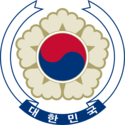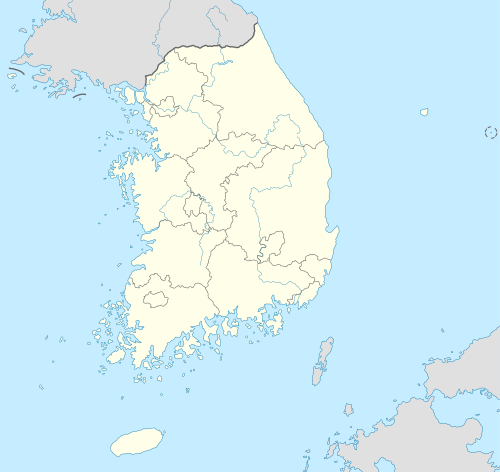التقسيمات الادارية في كوريا الجنوبية
تنقسم كوريا الجنوبية إلى 8 مقاطعات (دو 도/道)، مقاطعة خاصة ذاتية الحكم (teukbyeol jachido 특별자치도/特別自治道)، 6 مدن حضرية (gwangyeoksi 광역시/廣域市)، ومدينة خاصة (teukbyeolsi 특별시/特別市). هناك تقسيمات مزيدة حيث تنقسم المقاطعات إلى كيانات أصغر، وتشمل المدن (si 시/市)، الأقاليم (gun 군/郡) (gu 구/區)، البلدات (eup 읍/邑)، بلديات (myeon 면/面)، ضواحي (dong 동/洞) وقرى (ri 리/里)، كما هو مشروح أدناه. ملاحظة على الترجمة: بالرغم من أن المصطلحات "مدينة خاصة"، "مدينة عمرانية"، "محافظة"، و"مدينة" شائعة الاستخدام في المواقع الحكومية باللغة الإنگليزية، فإن الترجمات الأخرى — "county", "town", "district"، الخ.. — ليست ترجمات رسمية، لكن المقصود منها فقط أن تكون بمثابة تصوير توضيحي مفيد لمعنى كل كيان. الجزر الشمالية الغربية مثل جزيرة يونپيونگ، جزيرة باينگيونگ، جزيرة دايتشيونگ، وجزيرة سوتشيونگ الأصغر، هم جزء من اونگجين. . . . . . . . . . . . . . . . . . . . . . . . . . . . . . . . . . . . . . . . . . . . . . . . . . . . . . . . . . . . . . . . . . . . . . . . . . . . . . . . . . . . . . . . . . . . . . . . . . . . . . . . . . . . . . . . . . . . . . . . . . . . . . . . . . . . . . . . . . . . . . . . . . . . . . . . . . . . . . . . . . . . . . . . .الحكم المحليالمصطلحات الكورية تظهر في تهجي الرومنة المعدلة للكورية الرسمي.
تقسيمات على مستوى المحافظاتالتقسيمات على مستوى المحافظات هي تقسيم المستوى الأول في كوريا الجنوبية، وهي تنقسم بدورها إلى أربع مجموعات: محافظات، محافظة خاصة ذاتية الحكم، ومدينة خاصة ومدن عمرانية.
تقسيمات على مستوى البلدياتسي (مدينة)is one of the divisions of a province, along with گون. Cities have a population of at least 150,000; once a county (gun) attains that population, it becomes a city (Gijang county in Busan is an exception). Cities with a population of over 500,000 (such as Suwon, Cheongju, and Jeonju) are divided into districts (گو); Hwaseong and Namyangju are noticeable exceptions to this rule. Gus are then further divided into neighborhoods (دونگ); cities with a population of less than 500,000 do not have wards – these cities are directly divided into neighborhoods (دونگ). گون (مقاطعة)A gun (군; 郡) is one of the divisions of a province (along with si), and of the metropolitan cities of Busan, Daegu, Incheon and Ulsan (along with gu). A gun has a population of less than 150,000 (more than that would make it a city or si), is less densely populated than a gu, and is more rural in character than either of the other 2 divisions. Gun are comparable to British non-metropolitan districts. Counties are divided into towns (eup) and districts (ميون). گو (منطقة)A gu (구; 區) is equivalent to district in the West. Most cities are divided into gus, though the metropolitan cities of Busan, Daegu, Incheon and Ulsan contain guns as well. Gus are similar to boroughs in some Western countries, and a gu office handles many of the functions that would be handled by the city in other jurisdictions. Gus are divided into neighborhoods (دونگ). إيوپ (بلدة)An إيوپ (읍; 邑) is similar to the unit of town. Along with myeon, an إيوپ is one of the divisions of a county (gun), and of some cities (سي) with a population of less than 500,000. The main town or towns in a county—or the secondary town or towns within a city's territory—are designated as eups. Towns are subdivided into villages (ري). In order to form an إيوپ, the minimum population required is 20,000. ميون (بلدية)A myeon (면; 面) is one of the divisions – along with إيوپ – of a county (گون) and some cities (سي) of fewer than 500,000 population. Myeons have smaller populations than eups and represent the rural areas of a county or city. Myeons are subdivided into villages (ri). The minimum population limit is 6,000. دونگ (حي)A dong (동; 洞) is the primary division of districts (gu), and of those cities (si) which are not divided into districts. The dong is the smallest level of urban government to have its own office and staff. In some cases, a single legal dong is divided into several administrative dong. Administrative dongs are usually distinguished from one another by number (as in the case of Myeongjang 1-dong and Myeongjang 2-dong). In such cases, each administrative dong has its own office and staff. The primary division of a دونگ is the tong (통; 統), but divisions at this level and below are seldom used in daily life. Some populous dong are subdivided into ga (가; 街), which are not a separate level of government, but only exist for use in addresses. Many major thoroughfares in Seoul, Suwon, and other cities are also subdivided into ga. ري (قرية)A ri (리; 里) is the only division of towns (eup) and districts (myeon). The ri is the smallest level of rural government to contain any significant number of people.
التاريخAlthough the details of local administration have changed dramatically over time, the basic outline of the current three-tiered system was implemented under the reign of Gojong in 1895. A similar system also remains in use in كوريا الشمالية. انظر أيضاً
الهامشوصلات خارجية |



